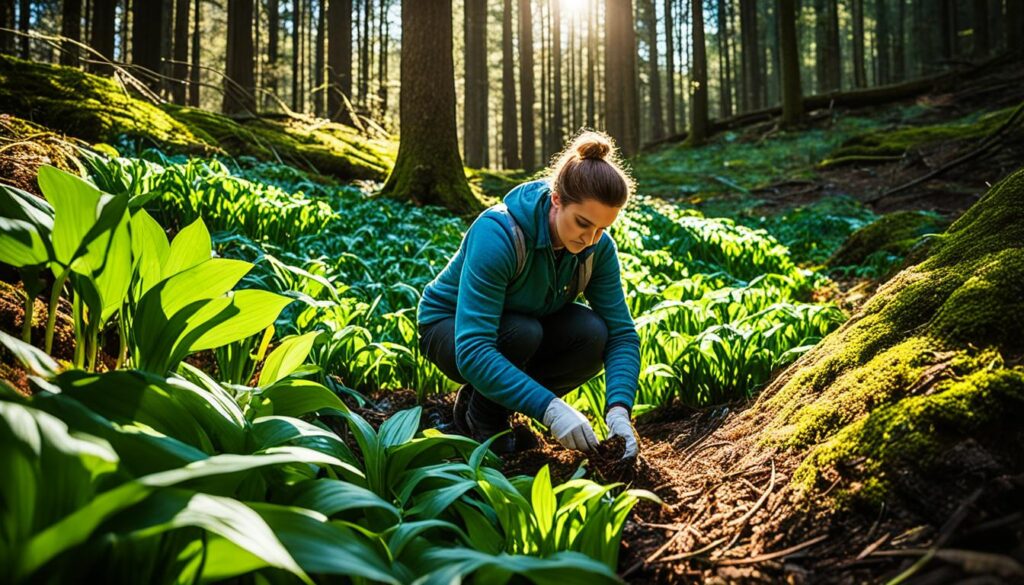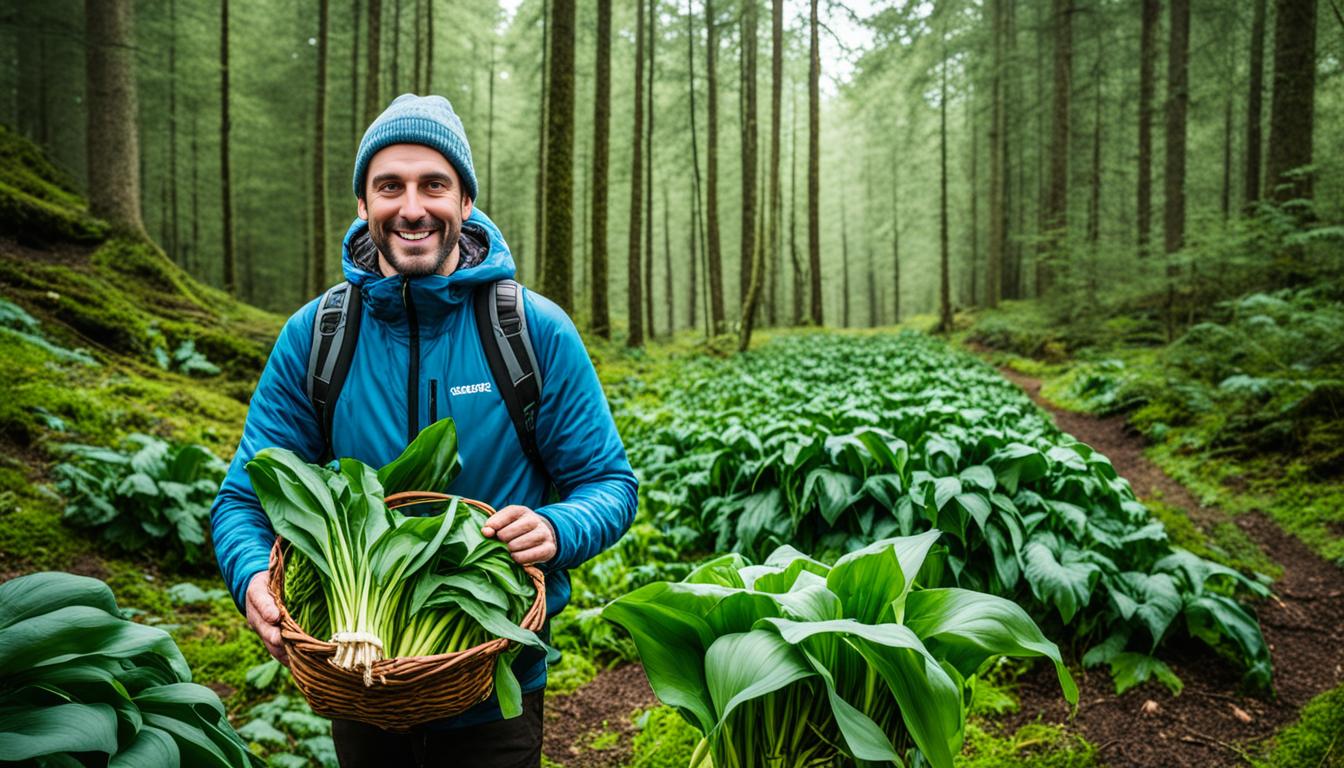Did you know that over the past decade, the demand for ramps (also known as wild leeks or wild garlic) has skyrocketed, leading to a dramatic decline in their populations across North America? This surge in popularity has resulted in the unsustainable harvesting of these wild alliums, putting their future at risk. As passionate foragers and nature enthusiasts, we believe it’s our responsibility to promote the ethical and sustainable management of ramps to ensure their preservation for generations to come.
In this comprehensive guide, we’ll explore the botany, life cycle, and proper harvesting techniques for ramps, equipping you with the knowledge to become a responsible and conscientious forager. By following the principles of sustainable harvesting and ethical foraging, we can protect the delicate balance of our forest ecosystems and safeguard the future of these cherished wild edibles.
Understanding Ramps: Botany and Life Cycle
Ramps, or Allium tricoccum, are a captivating type of wild onion native to North America, belonging to the esteemed Amaryllidaceae family. These remarkable plants are known for their distinctive garlicky-onion flavor, which has made them a beloved ingredient in regional cuisines across the continent.
What are Ramps?
Ramps are a unique and fascinating member of the onion family, with their broad, flat leaves and burgundy-colored stems standing out among the verdant forest foliage. At the base of these plants, you’ll find a flavorful bulb that has been a staple in the diets of many indigenous communities for centuries.
Ramp Identification and Look-alikes
Properly identifying ramps is crucial, as they can be easily mistaken for similar-looking plants, some of which can be potentially dangerous. One key distinguishing feature is the presence of a bulb at the base of the ramp plant. Additionally, ramps can be identified by their broad, flat leaves and burgundy-colored stems, setting them apart from look-alikes like lily-of-the-valley and false hellebore.
Habitat and Growing Conditions
Ramps thrive in the moist, well-drained soils of deciduous forests, typically found on north-facing slopes where they can bask in the dappled sunlight. Their preference for these specific growing conditions, along with their slow-growing nature, makes ramps particularly vulnerable to environmental changes and over-harvesting.
Ramp Life Cycle and Reproduction
Understanding the life cycle and reproductive patterns of ramps is essential for their sustainable management. These plants emerge in early spring, with their distinctive leaves and flower stalks appearing as the forest floor awakens from winter’s slumber. Ramps reproduce both sexually, through the production of seeds, and asexually, through the division of their underground bulbs.
ramps sustainable harvesting
Sustainable harvesting of ramps is essential to ensure the long-term survival of these prized wild edibles. By adopting ethical ramp foraging practices, we can not only enjoy the unique flavors of ramps but also contribute to the ramp conservation efforts that protect their ramp biodiversity and ramp ecosystem health.
Proper Harvesting Techniques
When harvesting ramps, it’s crucial to use ramps sustainable harvesting methods. This involves carefully cutting the leaves from the center of the ramp clusters, leaving at least two leaves behind. This practice allows the plant to continue growing and reproducing, ensuring that the ramp population can thrive for years to come.
Avoiding Over-harvesting
One of the primary threats to ramps is ramp over-harvesting, which occurs when the entire plant, including the roots, is removed. This practice not only depletes the ramp population but also halts the ramp’s life cycle, preventing the species from repopulating. By being mindful of our harvesting habits and only taking what we need, we can help ramp conservation efforts and preserve these precious wild alliums.
Ethical Foraging Practices
Ethical foraging is the cornerstone of sustainable ramp harvesting. This involves respecting the natural habitat, avoiding the removal of entire ramp clusters, and only taking what we need. By adopting these ethical ramp foraging practices, we can ensure that future generations can also enjoy the unique flavors and benefits of ramps.
Promoting Biodiversity and Ecosystem Health
Sustainable ramp harvesting not only benefits the ramp population but also supports the overall ramp ecosystem health. Ramps play a crucial role in the delicate balance of deciduous forests, and their presence is indicative of a healthy, biodiverse environment. By practicing ramps sustainable harvesting, we can contribute to the preservation of this vital ramp biodiversity.

Using and Preserving Ramps
Ramps are a versatile ingredient that can elevate a wide range of dishes. Whether you’re whipping up a savory pasta, topping a crisp pizza, or simmering a hearty soup, the distinct garlicky-onion flavor of ramps can add a delightful depth of flavor to your creations. Beyond their culinary applications, ramps are also a nutritional powerhouse, rich in vitamins A and C, as well as various essential minerals.
To preserve the vibrant flavors and nutritional benefits of ramps, we recommend exploring different preservation techniques. Pickling ramps is a popular method, allowing you to enjoy their unique taste long after the foraging season has passed. You can also experiment with making ramp-infused vinegars or seasoned salts to add a flavorful punch to your dishes. For the freshest ramp experience, aim to use them in your recipes as soon as possible after harvesting to fully capitalize on their aromatic and gustatory profile.
By incorporating ramps into your culinary repertoire and mastering the art of preservation, you can savor the bounty of this wild edible throughout the year, while also supporting sustainable harvesting practices that protect the longevity of ramp populations. Embrace the versatility of ramps and let their flavors shine in your culinary creations.
